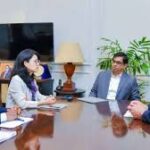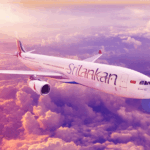
Made in Sri Lanka, Taxed in America, and Failed by the IMF
- CNL Reporter
- July 13, 2025
- Weekly Political Review
- Made in Sri Lanka
- 0 Comments
Weekly Political Review
Wide Angle Zoom in to US Tariff Blow and Diplomatic Failures
By Rohana Jith
Sri Lanka’s fledgling economic recovery faces a serious jolt after the United States finalized a 30% tariff on Sri Lankan exports—primarily apparel—exposing deep-rooted vulnerabilities in the island’s trade strategy and raising questions about the effectiveness of its current leadership’s international engagement. The tariff, which takes effect on August 1, is seen not only as an economic setback but also as a diplomatic failure rooted in weak global bargaining and poor communication from Colombo.
Once threatened at 44%, the tariff was reduced to 30% following weeks of behind-the-scenes efforts by officials including Central Bank Governor Dr. Nandalal Weerasinghe and Ambassador to the U.S. Mahinda Samarasinghe. But this has offered only partial relief to the country’s top export sector, with the blow falling heavily on apparel manufacturers already struggling with high input costs, declining orders, and fragile post-crisis recovery.
According to data, Sri Lanka exported over $1.9 billion worth of garments to the U.S. in 2024, accounting for nearly 40% of its total apparel exports. This sector employs over 300,000 people, mostly women, and serves as a critical source of foreign exchange. With the new tariff in place, Sri Lankan goods will now face higher U.S. duties than key competitors like Vietnam (20%), India (26%), and Bangladesh (35%), threatening the country’s share in a shrinking global apparel market.
A Diplomatic Fumble?
While Colombo managed to prevent the harsher 44% tariff, the 30% duty still represents a strategic failure on multiple fronts. Analysts argue that the current administration, led by President Dissanayake, failed to capitalize on early warning signs and did not mount a robust diplomatic response when the proposed tariffs were first floated earlier this year.
A telling example of the diplomatic lapse came when the White House’s official communication to the Sri Lankan President reportedly misspelled his name as “Aruna” Dissanayake—a glaring error interpreted as symbolic of Sri Lanka’s diminished stature in the eyes of major powers. Critics within Sri Lanka’s diplomatic corps point to this as evidence of poor communication, lack of protocol coordination, and failure to command serious attention in Washington.
Moreover, observers argue that Sri Lanka’s global diplomatic posture has weakened under the current leadership, which has largely relied on technocratic interventions and domestic political maneuvering rather than proactive bilateral engagement. Despite several rounds of informal communication with U.S. trade authorities, there was no strong show of state-level lobbying, nor was a coherent trade strategy presented to counter the tariff threat.
Missed Opportunities and Political Fallout
The government’s slow and fragmented response is increasingly being questioned, especially as neighboring countries like Vietnam and Bangladesh are reportedly negotiating improved terms under preferential trade arrangements. Sri Lanka, on the other hand, remains without a meaningful bilateral or multilateral cushion, having exited the U.S. Generalized System of Preferences (GSP) in 2021 and failing to reinstate any special access since.
President Dissanayake, who came to power on promises of rebuilding Sri Lanka’s international credibility after the 2022 crisis, now finds himself under pressure from within his own coalition and the opposition. His critics allege that he has failed to rise to the occasion on the international stage, often appearing reactive rather than strategic in foreign policy matters.
A three-week “economic offensive” launched this week by the Foreign Ministry and Central Bank aims to engage U.S. lawmakers, lobbyists, and trade experts in a last-ditch effort to revise the tariffs. However, with less than three weeks left until implementation, officials privately admit that prospects for further concessions are slim.
The Bigger Economic Picture
The tariff impact is more than symbolic—it could cost Sri Lanka an estimated 1% of GDP this year alone. The IMF, in its latest advisory, warned that the country remains vulnerable to external shocks due to its overreliance on a narrow export base and weak institutional response to trade volatility.
The apparel sector alone could see over $600 million in lost earnings as U.S. buyers pivot to cheaper alternatives in India and Southeast Asia. This coincides with reduced global demand for consumer goods, further shrinking Sri Lanka’s market share.
Already, exporters are lobbying for new markets, and discussions are underway with the United Kingdom for inclusion under its Developing Countries Trading Scheme by 2026. But this comes too late to offer immediate relief. With Sri Lanka’s economy still adjusting to IMF-driven fiscal discipline, tight monetary policy, and high debt repayments, the tariff shock threatens to slow the pace of fragile recovery.
Political Developments This Week
As the tariff debate dominated economic headlines, several political developments unfolded:
Emergency Cabinet Meetings: President Dissanayake held multiple high-level meetings with finance and foreign ministry officials to discuss mitigation strategies and alternative export destinations.
UK Trade Outreach: The British High Commissioner met with the Prime Minister to discuss potential duty-free garment access under the UK’s upcoming 2026 trade scheme.
Governance Issues: A new round of allegations surfaced regarding pardons granted to high-profile prisoners, while the Attorney General indicted a former national cricketer for undisclosed financial misconduct.
Opposition Rallies: The opposition Samagi Jana Balawegaya staged a protest in Colombo, calling the government’s tariff response “too little, too late” and demanding the resignation of Trade Minister Janaka Silva.
Foreign Dignitaries: UN Human Rights Commissioner Volker Türk and former South African President Thabo Mbeki visited Colombo, though their visits were unrelated to the trade issue.
Conclusion
The 30% tariff is not merely an economic concern—it has emerged as a political flashpoint highlighting the limitations of Sri Lanka’s current international strategy and leadership. While some damage control is underway, the episode reveals a broader need for institutional strengthening, export diversification, and a reimagined foreign policy capable of defending the country’s interests in an increasingly protectionist global landscape.
With August 1 approaching fast, Sri Lanka stands at a crossroads—either adapt to shifting global realities or risk being left behind in a world where trade diplomacy is as important as trade itself.

